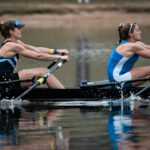Behind the Venue: Gales Ferry Boathouse and 143 years of intercollegiate rowing
Gales Ferry Boathouse has hosted the Yale heavyweight crew team for 143 years as members prepare for the Yale-Harvard Race, the nation’s oldest intercollegiate sporting event. Since The Race’s transition to the Thames River, Yale has defeated Harvard 54 times.

Anasthasia Shilov, Illustrations Editor and Zully Arias, Production and Design Editor
“Behind the Venue” is a series of feature-form articles that dives into the history, character and most memorable moments of Yale’s various athletic forums — from stadiums and fields to pools and boathouses. While not all articles in the series will resemble one another, all attempt to take a deeper look into how these places came to be and how they have fared over time. This article is the 12th in the series.
Gales Ferry Boathouse is filled with the memories of rowers, coaches and alumni, dating back to 1907, when Yale bought the original house located on the compound. Home to Yale’s heavyweight crew team and the nation’s oldest intercollegiate sporting event, the Yale-Harvard Race, The Ferry is monumental to the history of national and Yale rowing.
The early history
The Gales Ferry Boathouse dates back to even before Yale’s purchase of the original house over a century ago — the Geer House was originally built in 1796 by Thomas Geer. Located in Gales Ferry, New London, a village established on the Thames in 1740, the compound was the landing site for the town’s ferry.
The Geer House was originally a gambrel-roofed Cape Cod house owned by Thomas and George Geer. In 1799, it was sold to Captain Alexander Allyn, a mariner in the coastal trade. The house remained in the Allyn family until 1904, when George St. John Sheffield, a benefactor to Yale rowing, acquired it.
The Yale-Harvard Regatta, commonly known as The Race, officially commenced in 1852 and was first held at the Thames River in 1878. During the years in between, Harvard and Yale’s crews raced in Winnipesaukee, Springfield, Worcester and Saratoga. Since 1878, the town of Gales Ferry has been home to Yale’s heavyweight crew in preparation for The Race. At the time, the compound included the Latham Brown House and Thomas Geer House, which had been enlarged to house the crew team. In the early 1900s, James Gamble Rogers, who also designed several Yale libraries and colleges, designed a large boathouse to store the rowing shells. The original buildings are currently preserved in the compound, and a third building built in 1905 to house the coaching staff.
Payne Whitney, 1898 heavyweight rowing captain, also contributed significantly to Gales Ferry. According to Kim Hutchins Millar, who owns a retirement home in Gales Ferry, Whitney funded the construction of a cottage on the grounds between 1910 and 1920, which was primarily used for coaches and spectators who gathered around the Thames to watch the Regatta. Local arsonists burned the cottage down in 1975.
The Race
In the 1800s, prior to the expansion of the Geer House, Yale and Harvard crews would move in with residents of the area when racing at Gales Ferry, according to men’s heavyweight crew head coach Steve Gladstone.
Currently, The Race is held each year in early June. Immediately after finals, Yale’s heavyweight crew team moves out of their dorms and into Old Campus. After nationals, which usually occur at the end of May, the crew, along with the coaches and a series of volunteers who maintain the house and cook for the team, drives an hour to Gales Ferry, where they stay for two to three weeks to train for and compete in The Race.
Originally, The Race was restricted to the two varsity crews, but it later expanded to include additional events. The junior varsity race was implemented in 1899 and the freshman race in 1893. Today, freshman crews compete for the New London Cup in a 2-mile race, junior crews compete for the F. Valentine Chappell Trophy in a 3-mile race and the first varsity boats compete for the Sexton Cup in a 4-mile race.
At the culmination of The Race, both varsity teams paddle back to their respective boathouses, where they meet cheerful spectators, friends and family.
“But there’s this one quiet moment before that, when they’re together for the last time putting their oars in the water, doing what they’ve done so many millions of times in their career, and it’s this sort of touching moment right before the excitement and the energy,” Joel Furtek ’90, crew operations coordinator at Yale who rowed with the lightweight crew, said.
The crew rows with no crowd cheering them on — just the coach following closely behind. For some, this is the last row of their Yale career. For all, The Race each year is their last time a crew rows together as the varsity eight. According to Furtek, tears are visible in many of the oarsmen’s eyes.
Gales Ferry today
Today, the compound consists of three buildings: the Varsity House, Manager’s House and the Boathouse. First-year oarsmen reside on the second floor of the Boathouse, above the rowing shells. Upperclassmen reside in the Varsity House, which also contains several common spaces including a dining room, common room and game room.
“There is nothing fancy up there,” Gladstone told the News. “It is basic, but it does not need to be fancy. It is functional.”
Former Yale oarsman Stephen Kiesling ’80, who competed on the 1980 U.S. Rowing Olympic Team and in the 2008 Olympic Rowing Trials, shared Gladstone’s sentiments.
Kiesling told the News that in the late 1970s, during his time at Yale, the compound was “pretty funky.” He said that the facilities, especially the bathrooms and showers, were especially outdated, so much so that it might have been worth it to walk to town to avoid using them.
The compound is not only isolated from the outside world and any possible distractions, but there is also no WiFi access. In this aspect, Gales Ferry has remained similar to its earlier years, where oarsmen occupied themselves with croquet matches, reading or writing. Kiesling wrote the first 90 pages of his senior thesis, which later inspired the book “The Shell Game: Reflections on Rowing and the Pursuit of Excellence,” at the compound in between practices.
Traditions at the venue
“[Gales Ferry Boathouse] has a long history,” Gladstone said. “In some ways, it truly is the home of the heavyweight crew. Even though it is used a limited amount of time during the course of the year, it becomes a place that they are probably most emotionally attached to.”
According to Jim Millar ’80 — who rowed along with Kiesling and now owns a retirement home next to Gales Ferry with his wife, Hutchins Millar — the boathouse has seen many different traditions, which fluctuate over the years as the oarsmen graduate.
During his time at Yale, first years were required to perform a skit for the upperclassmen, which were mainly created to make fun of the upperclassmen. Another tradition that Millar remembers are the croquet tournaments, which would be led by a game master, who would implement his own rules. Kiesling said that the rules were “completely arbitrary,” but that the games were “pretty fun.”
“Back then, one of the big things we did was to try and build microphones for the shells, because that was before there were talk boxes,” Kiesling said. “And we had a couple of guys, who are really into electronics and so they were building these fancy microphones. It was actually quite helpful.”
Both Kiesling and Millar also mentioned that the crew would watch movies provided by alumni through a projector. At the time, a graduated oarsman worked in the movie distribution business, and he provided the crew with newly released films to watch during their free time.
This tradition carried on throughout the years. Furtek told the News that during his time at Yale as an undergraduate, he had the opportunity to stay at Gales Ferry, and while he was there, the crew would watch parts of a movie every night.
“What’s amazing about it is to be in a place where there is nothing but rowing,” Kiesling said. “You wake up in the morning and it may be cold and dark and raining, and you go out and row, and that’s just what you’re going to do. And it’s really wonderful. It’s really a Spartan kind of living in the best sense of that word, where it’s all about your duty to the crew and focus on The Race.”
Another tradition that takes place after the winner of the Sexton Cup is announced is the painting of the rock by the Thames. Depending on the winner, the rock is painted either red or blue, with the letters corresponding to each school painted in white. For the past six years, the rock has been blue.
But that streak did not come easily.
Since 1852, Harvard has won 95 of the varsity races, while Yale has won 58.
In 2015, Yale defeated for the first time Harvard since 2007 and since Gladstone began heading the program in 2010.
“It’s all about The Race. It’s all about winning The Race,” Gladstone said. “[2015] was the breaking of the ice, so to speak. It was the beginning of a good streak that we have going against Harvard.”
The last Yale-Harvard Regatta took place on June 8, 2019.









